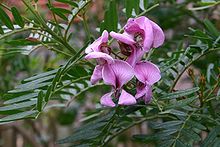Virgilia oroboides
| Virgilia | |
|---|---|
 |
|
| Virgilia divaricata | |
| Scientific classification | |
| Kingdom: | Plantae |
| (unranked): | Angiosperms |
| (unranked): | Eudicots |
| (unranked): | Rosids |
| Order: | Fabales |
| Family: | Fabaceae |
| Subfamily: | Faboideae |
| Tribe: | Podalyrieae |
| Genus: |
Virgilia Poir. |
| Species | |
|
|
| Synonyms | |
|
|
Virgilia is a genus of Southern African trees in the family Fabaceae, having shiny to hairy pinnate leaves and attractive mauve to pink pea-shaped flowers followed by leathery pods. They are valued as useful ornamental trees by gardeners, particularly the well-known species Virgilia divaricata ('Tree in a Hurry', 'Cape Lilac', 'Blossom Tree') and Virgilia oroboides ('Pink Blossom Tree'), despite having a comparatively short life (15 years). They prefer well drained soils; some will then grow 2m in the first season. They will tolerate wind and have dense foliage growing close to the ground, so they are useful as pioneer species for privacy and wind protection. The common name in South Africa (in Afrikaans) is keurboom, meaning 'choice tree'.
Most botanists feel that the two species are simply forms and should be lumped under one species, Virgilia oroboides. That would mean that the current V. divaricata is simply a darker form limited to the forested region of Knysna, South Africa. Virgilia oroboides had a number of synonyms, while both V. oroboides and V. divaricata had both been named V. capensis by different authors.
...
Wikipedia
